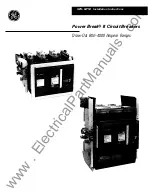
Potential
Transformer
Module
Terminal
Block
Shutter
Shunt Trip
Trip Plate
Power Relay
Module
Digitrip Trip
Unit
Auxiliary
Switches
Emergency
Charge Handle
Spring Charge
Motor
Opening
Spring
Spring Charge Indicator
Hold Pawl
Figure 3-16 Power Operated DSII Breaker (Front Cover Removed)
3-10.5 Latch Check Switch
The latch check switch consists of a switch mounted on the
inside of the left hand breaker side sheet. It is located such
that when the breaker trip shaft is in the “reset” position, a
normally closed contact of the switch is closed (Figure 3-17).
When the switch is supplied, the contact is usually con-
nected in the closing circuit of the breaker to insure that the
tripping system is reset before the circuit can be energized
to close the breaker.
3-10.6 Auxiliary Switch
Up to two auxiliary switches can be mounted on a breaker
(Figure 3-16). They are stacked units located in the right front
portion of the breaker chassis. Each switch has nine con-
tacts which may be normally open “a” or normally closed
“b” contacts. Auxiliary switch contacts are rated 10 amperes
at 120/240 volts AC, 10 amperes at 125 volts DC, and 2 am-
peres at 250 volts DC. Two normally open and two normally
closed contacts or five normally open and five normally
closed contacts are available for use on both manually and
power operated breakers.
3-10.7 Undervoltage Trip Attachment (UVTA)
The undervoltage trip attachment is optional on both manu-
ally or power operated breakers. The undervoltage trip
attachment is an electromechanical device that trips the
breaker when the voltage on its coil falls to between 30 to
60 percent of normal. The standard unit trips instantaneous-
ly. A similar device is also available with a non-adjustable
time delay, intended to ride through momentary fluctuations
of system voltage.
In operation, a moving core is normally held magnetically
against a stationary core and a spring. This is linked to a latch
carrying a roller which restrains the main tripping lever of
this assembly (Figure 3-18). When the coil voltage is suffi-
ciently reduced, a spring overcomes the magnetic attraction
between the two cores. The moving core travels upward,
and rotates the latch counterclockwise so the roller moves
from beneath the tail of the main tripping lever. A torsion
spring around the pivot pin of the tripping lever then rotates
it counterclockwise, causing a projection on right side of this
lever to strike a pin in the mechanism trip shaft. The result is
that the trip shaft rotates clockwise and trips the breaker.
Effective July 2010
Instructional Book
IB694C694-03
26
eaton corporation
www.eaton.com
















































